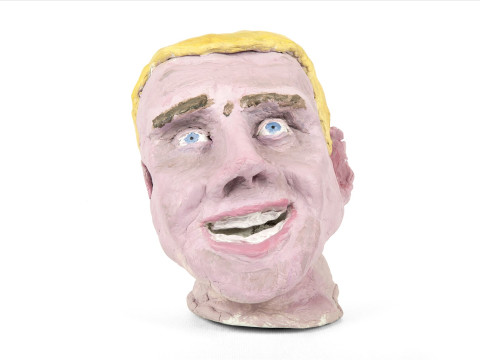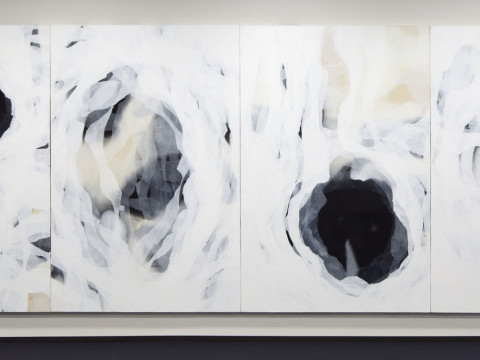
In the studio with Yinka Shonibare RA
By Fiona Maddocks
Published on 29 February 2016
As Yinka Shonibare RA prepares to wrap the Academy’s Burlington Gardens façade in his bold designs, Fiona Maddocks visits the sculptor at his warehouse studio in east London.
From the Spring 2016 issue of RA Magazine, issued quarterly to Friends of the RA.
Less than a decade ago, when Yinka Shonibare RA bought his studio fronting on to the Regent’s Canal in east London, the neighbourhood was still, in his words, "distinctly rough at the edges and slightly scary". Now this area of Hackney is alive with artisan cafés and the whizz-ding sound of expensive bicycles speeding along the regenerated towpath. Shonibare is at the epicentre of urban gentrification. Elegant in sharp blue suit, he presumably set the trend rather than followed? He chuckles gently at the idea. "As if. This was always an area with a lot of studios and a lot of artists, still affordable back in 2008." The building used to be a carpet warehouse.
Shonibare opened up the roof space, had the partition walls pulled down, sand-blasted the wood floor and instructed his architect to "renovate it so that it is still like a warehouse and feels as if nothing has been done". Exposed brick, whitewash and a big skylight achieve exactly that. The first-floor space, airy and well ordered, is where he develops most of his projects, and where his team of three work. "And it’s where I meet with sculptors, costumiers, photographers, printmakers – the people I collaborate with."
He draws and makes other work on paper either here, or at his studio at home in Bow. His series of prints about twins are displayed on the wall. "In Nigeria twins are considered special and have magic powers in folklore. I’m doing these for a show in Singapore about childhood memories. It’s also a metaphor for dual cultures."
At once African and British, Shonibare has been shaped both by colonialism and post- colonialism, and explores these themes in his work. His forthcoming commemoration of the First World War for Turner Contemporary, Margate, will focus on refugees and immigration past and present. An old blue-and-white china plate with the inscription ‘The Unity of Empire’ hangs on the wall behind where we sit. Nearby is the maquette for Nelson’s Ship in a Bottle (2010), his sculpture that occupied the Fourth Plinth in Trafalgar Square. On the floor stands a figure of a child, with globe head and blowing a trumpet, dressed in one of the richly coloured African Dutch-wax textiles he often uses in his work.
"I’m interested in where people come from," he says. "I can’t be defined without the British-colonial experience of my birth and background. I don’t exist without it. My biggest preoccupation is with the idea of universal humanism. We all influence each other. Can you imagine Picasso without African art?"
Born in Britain in 1962, Shonibare moved with his family back to Nigeria as a child. His father was a corporate lawyer, his mother looked after the four children. At 17 he returned to the UK and went to Wimbledon College of Art for his foundation year. "Three weeks into the course I fell ill with transverse myelitis and was in a coma for a fortnight. It affected my spinal cord. When I woke up I was paralysed from the neck down."
Eventually he gained some movement on one side and returned to art school, progressing to an MA at Goldsmiths. Charles Saatchi bought his early work and Shonibare came to prominence after his inclusion in the RA’s Sensation show in 1997. Elected an Academician in 2013, he has just finished a vast artwork that wraps around the front of the Burlington Gardens building, while the façade undergoes restoration work as part of the RA’s redevelopment project. "I’ve dug into the archive and found hundreds of photos from the early 20th century showing how the building has changed. Until I was a Member I always thought the Academy was quite mysterious. With this work I’m trying to bring the inside outside." In addition, his bejewelled designs feature on the new Friends cards, in blue, gold or black.
At his canal-side studio he also hosts supper parties for artists. His manner may be quiet but his nature is flamboyant. "I wanted this space to be not just for me, but for others to try things out. So I have a proposal box outside the building where artists can post their ideas. The best ones get a residency in the studio for a month." When we meet, an Afro-Caribbean theatre group is in situ. As we talk South African songs waft up from below. ‘Yes, it’s quite a sociable space,’ Shonibare says, as the harmonies grow louder and threaten, in the nicest way, to drown us out.
Yinka Shonibare’s wrap artwork can be seen outside the RA at Burlington Gardens from April 2016.
End of Empire is at Turner Contemporary, Margate, from 22 March – 30 October 2016.
Childhood Memories is at Pearl Lam Galleries, Singapore, until 20 March 2016.
Fiona Maddocks is a journalist, broadcaster and Classical Music Critic for the Observer.

Enjoyed this article?
As well as free entry to all of our exhibitions, Friends of the RA enjoy one of Britain’s most respected art magazines, delivered directly to your door. Why not join the club?
Related articles

Six trends we spotted at the biggest art fair in the UK
10 October 2024

In the studio with Hew Locke RA
6 October 2022

Jock McFadyen RA: postcards from a post-apocalyptic future
28 February 2022


